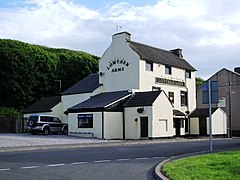Parton, Cumbria
| Parton | |
|---|---|
| Village and parish | |
 Lowther Arms public house, Parton | |
Location within Cumbria | |
| Population | 914 (2011)[1] |
| OS grid reference | NX979205 |
| Civil parish |
|
| Unitary authority | |
| Ceremonial county | |
| Region | |
| Country | England |
| Sovereign state | United Kingdom |
| Post town | WHITEHAVEN |
| Postcode district | CA28 |
| Dialling code | 01946 |
| Police | Cumbria |
| Fire | Cumbria |
| Ambulance | North West |
| UK Parliament | |
| Website | https://partonparishcouncil.com/ |
Parton is a village and
History
Beginnings
The sheltered anchorage in Parton Bay was used by the
18th century prosperity
Unfortunately, Parton Bay is not as well sheltered as Whitehaven, and within about 15 years, Lamplugh was unable to afford maintenance costs (possibly a contributory factor to the closure of the glassworks and salt-pan about this time). The manor of Moresby was bought in 1722 by one Thomas Brougham, who was able to sideline Lamplugh and develop the port himself, but ironically, in 1738, he sold his rights to the Lowther family. Surprisingly, rather than shut down the port which rivalled Whitehaven, they used it themselves for some of their coal shipments, and Parton prospered for decades. New industries developed, most notably a brewery, but everything was nearly wrecked in 1795, when a storm destroyed the harbour breakwaters. With such extensive damage, the harbour reverted to being a little fishing haven, but the village industries had enough local custom to survive, for a while at least.[citation needed]
Surprisingly, a new and important industrial concern opened to the north of the village in 1800, the
19th century onward
In 1840 the Lowca engineering works of Tulk and Ley made the first locomotive for the new Maryport and Carlisle Railway, but ironically, it had to be transported from Parton by seagoing barge. Not until several years later was the technically challenging railway extension to Whitehaven via Parton developed. The railway soon supplanted the old tramway, and brought new opportunities for Parton's industries. The colliery, the engineering works and the brewery all thrived, an iron-foundry opened next to the new railway station, and in the 1870s an ironworks was established on the shore near the Lowca works. Unfortunately, the end of the 19th century was a period of industrial consolidation, and Parton's relatively small businesses began to struggle.[citation needed]
By the 1920s, almost all were gone, and Parton became a dormitory town for collieries around Lowca and Whitehaven. Many of the houses in the old village were over 200 years old by this time, and were classified as slums, so over the next half-century new housing estates were developed on top of the Brows- the escarpment overlooking the old port. Although the local collieries have all closed, Parton's dormitory function continues, thanks to its good transport access. Moresby Hall and parish church remain, just outside the village boundary, on the high ground to the north of Parton.[citation needed]
Governance
Parton is within the Copeland UK Parliamentary constituency, Trudy Harrison is the Member of parliament.[3]
Before Brexit, its residents were covered by the North West England European Parliamentary Constituency.
For
The village also has its own
Gallery

See also
References
- ^ Office for National Statistics. Retrieved 24 April 2021.
- ^ UK Census (2001). "Local Area Report – Parton Parish (16UE020)". Nomis. Office for National Statistics. Retrieved 24 April 2021.
- ^ "Copeland UK Parliamentary constituency".
- ^ "Parton Parish Council".
Further reading
- Bradbury, D. "Parton Part One: Story of a Cumbrian Village from Its Beginnings to 1930 Pt. 1 (History of Parton)", ISBN 978-1904367048
- Bradbury, D. "Parton Part Off: The Reshaping of a Cumbrian Village from the 1920s to the 1970s", ISBN 978-1904367192
External links
- Cumbria County History Trust: Parton (nb: provisional research only – see Talk page)
![]() Media related to Parton, Copeland at Wikimedia Commons
Media related to Parton, Copeland at Wikimedia Commons


